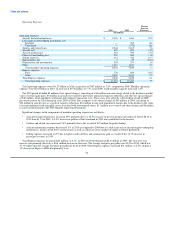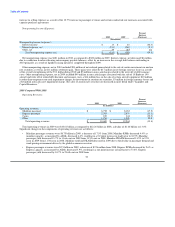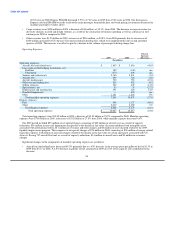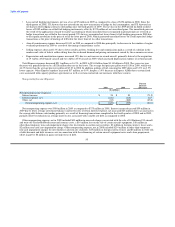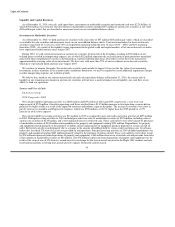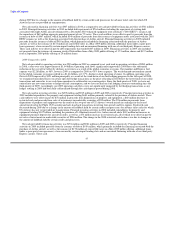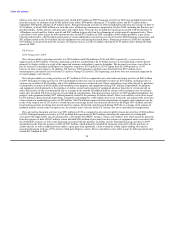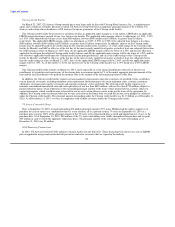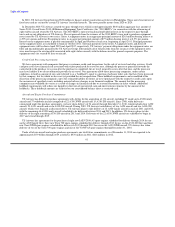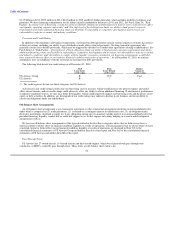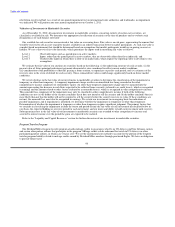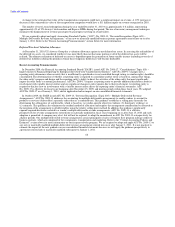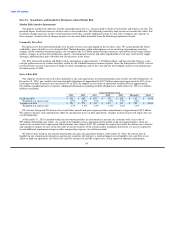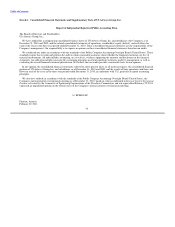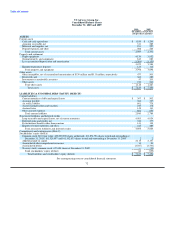US Airways 2010 Annual Report Download - page 63
Download and view the complete annual report
Please find page 63 of the 2010 US Airways annual report below. You can navigate through the pages in the report by either clicking on the pages listed below, or by using the keyword search tool below to find specific information within the annual report.
Table of Contents
$1.15 billion in 2013, $935 million in 2014, $445 million in 2015 and $2.18 billion thereafter, which includes predelivery deposits and
payments. We have financing commitments for all Airbus aircraft scheduled for delivery in 2011 and 2012. See Part I, Item 1A, "Risk
Factors - Increased costs of financing, a reduction in the availability of financing and fluctuations in interest rates could adversely affect
our liquidity, operating expenses and results" and "Our high level of fixed obligations limits our ability to fund general corporate
requirements and obtain additional financing, limits our flexibility in responding to competitive developments and increases our
vulnerability to adverse economic and industry conditions."
Covenants and Credit Rating
In addition to the minimum cash balance requirements, our long-term debt agreements contain various negative covenants that restrict
or limit our actions, including our ability to pay dividends or make other restricted payments. Our long-term debt agreements also
generally contain cross-default provisions, which may be triggered by defaults by us under other agreements relating to indebtedness. See
Part I, Item 1A, "Risk Factors – Our high level of fixed obligations limits our ability to fund general corporate requirements and obtain
additional financing, limits our flexibility in responding to competitive developments and increases our vulnerability to adverse economic
and industry conditions" and "Any failure to comply with the liquidity covenants contained in our financing arrangements would likely
have a material adverse effect on our business, financial condition and results of operations." As of December 31, 2010, we and our
subsidiaries were in compliance with the covenants in our long-term debt agreements.
The following table details our credit ratings as of December 31, 2010:
S&P Fitch Moody's
Local Issuer Issuer Default Corporate
credit rating credit rating Family rating
US Airways Group B- CCC Caa1
US Airways B- * *
(*) The credit agencies do not rate these categories for US Airways.
A decrease in our credit ratings could cause our borrowing costs to increase, which would increase our interest expense and could
affect our net income, and our credit ratings could adversely affect our ability to obtain additional financing. If our financial performance
or industry conditions worsen, we may face future downgrades, which could negatively impact our borrowing costs and the prices of our
equity or debt securities. In addition, any downgrade of our credit ratings may indicate a decline in our business and in our ability to
satisfy our obligations under our indebtedness.
Off-Balance Sheet Arrangements
An off-balance sheet arrangement is any transaction, agreement or other contractual arrangement involving an unconsolidated entity
under which a company has (1) made guarantees, (2) a retained or a contingent interest in transferred assets, (3) an obligation under
derivative instruments classified as equity or (4) any obligation arising out of a material variable interest in an unconsolidated entity that
provides financing, liquidity, market risk or credit risk support to us, or that engages in leasing, hedging or research and development
arrangements with us.
We have no off-balance sheet arrangements of the types described in the first three categories above that we believe may have a
material current or future effect on financial condition, liquidity or results of operations. Certain guarantees that we do not expect to have
a material current or future effect on our financial condition, liquidity or results of operations are disclosed in Note 9(f) to the
consolidated financial statements of US Airways Group included in Item 8A of this report and Note 8(f) to the consolidated financial
statements of US Airways included in Item 8B of this report.
Pass Through Trusts
US Airways has 27 owned aircraft, 114 leased aircraft and three leased engines, which were financed with pass through trust
certificates, or EETCs, issued by pass through trusts. These trusts are off-balance sheet entities, the
62


